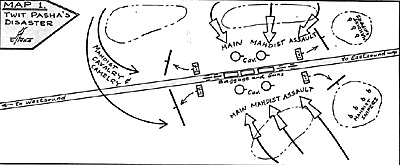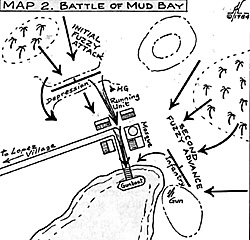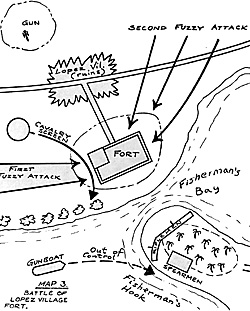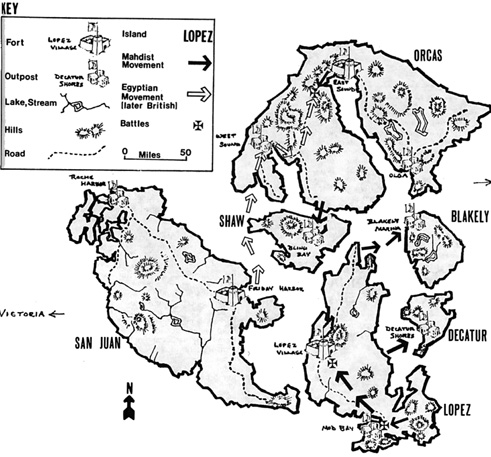Twit Pasha set sail from Friday Harbor with five gunboats escorting transports carrying nearly 2,000 men and 10 artillery pieces. His goal was the relief of Eastsound, the recapture of Orcas Island and the defeat of the Mahdi. Common sense would seem to have indicated a direct waterborne advance all the way to Eastsound. Indeed, the Governor-General, Akbar Pasha suggested such an approach. Twit Pasha, however, placed more reliance on his questionable spies than on common sense. Fearing a possible Mahdist trap along the lengthy shores of East Sound, Twit Pasha chose instead to sail to Deer Harbor, disembark there and march overland to Eastsound.
The Mahdi's spies, much more reliable and efficient than their Egyptian counterparts, knew of Twit Pasha's intentions within hours of the departure of the Egyptian flotilla. The Mahdi's plan was to allow the relief force to advance, unmolested, into the hills outside Eastsound. When the Egyptian column was in the restricted passes between the hills, he would release his Ansar, now swollen to over 10,000, to overwhelm Twit Pasha's men. The Egyptians, surprised by the lack of Mahdist resistance, failed to realize they were marching into a trap.
Referee's comments: Because of the size of this action, the W3 IMPERIALISM Rules were used. The Mahdists outnumbered the Egyptians four-to-one in units. The only Egyptian advantage was in guns, and the restricted spaces of the pass and the hills severely limited this advantage. The poor quality of the Egyptian cavalry - hashish-smoking Bashi- Bazouks mostly - was reflected by their total lack of preparation for a possible ambush. Twit Pasha's troops were strung out in line, rather than advancing through the pass in square. Since the outcome of this battle was pretty much decided from the start, I chose to fight it as a solo action.
I did include several dice-roll options for the Egyptian units to represent their response to the actions of the Mahdists. I'm not sure whether the dice knew my intentions or not, but they consistently rolled about as bad as they could. Even had the dice been kinder to the Egyptians, however, the Mahdists would have eventually won anyway.
It was late afternoon on the third day of the advance from Deer Harbor. Twit Pasha had decided to press on to Eastsound rather than camp for the night. Having heard nothing from Aboukir Bey since he landed on Orcas Island, he feared the worst. The advance was halted by sporadic rifle fire from the front. Before Twit Pasha could reach the Mahdi's cavalry and camel troops struck from behin the column in an encircling movement. Suddenly, the Egyptian route of retreat was cut off. There was now no option but to fight it out.
The Mahdist mounted troops stayed back from the rear of the column. Twit Pasha ordered his rear infantry to form line and engage the enemy cavalry in a firefight. His lead units were sent forward to clear the hills to the front of the Ansar snipers. Surprisingly, the Egyptian cavalry were held back to guard the baggage train and the artillery. As the snipers and the cavalry drew most of the Egyptian infantry away from the column, the main Mahdist force struck.
 Screaming as they charged out of the hills, nearly 3000
spear and sword-wielding Ansar descended upon the
artillery, cavalry and baggage before the guns could even be
deployed. The Egyptian cavalry which were not killed thus
turned and fled through the Egyptian infantry at the rear of the
column. The Mahdist cavalry now charged and wiped out the
retreating Bashi-Bazouks. The charge continued on and broke
through the Egyptian infantry. Twit Pasha ordered the
remnants of his command into square and
attempted to fight his way through the Mahdist riflemen to his
front. The fast-moving Ansar melee troops soon reached the
square and began hurling themselves against the Egyptians.
The end was not long in coming. The square was pierced on
two sides and virtually no Egyptian troops survived the
carnage.
Screaming as they charged out of the hills, nearly 3000
spear and sword-wielding Ansar descended upon the
artillery, cavalry and baggage before the guns could even be
deployed. The Egyptian cavalry which were not killed thus
turned and fled through the Egyptian infantry at the rear of the
column. The Mahdist cavalry now charged and wiped out the
retreating Bashi-Bazouks. The charge continued on and broke
through the Egyptian infantry. Twit Pasha ordered the
remnants of his command into square and
attempted to fight his way through the Mahdist riflemen to his
front. The fast-moving Ansar melee troops soon reached the
square and began hurling themselves against the Egyptians.
The end was not long in coming. The square was pierced on
two sides and virtually no Egyptian troops survived the
carnage.
News of the demise of the Relief Expedition soon reached Aboukir Bey at Eastsound - in the form of artillery shells from the newly captured Krupp guns. The end for the besieged garrison was now in sight. They hung on as long as they could, but the fort was finally stormed and the garrison wiped out after a siege that had lasted over a month. All of Orcas Island was now in the hands of the Mahdi. He now began planning the conquest of the entire San Juan Archipelago.
The continued successes of the Mahdists had a very persuasive effect on the leader of the here-to-fore neutral Lopez Island Hadenclowah natives. Osman Digna, seeing the possibility to ride to glory on the Mahdi'sjibba-tails (so to speak) rose against the Egyptian garrisons on Lopez and the neighboring islands of Blakely and Decatur. The Hadenclowah "Fuzzy-Wuzzies" proved to be worthy adversaries for the Egyptian troops on the Eastern islands.
The Egyptian commander at Mud Bay, Sulva Bey, was ordered to abandon his garrison duties and march to Lopez Village in order to bolster the garrison of the fort there. Sulva Bey, a bit rash and totally ignorant of the abilities of his enemy, chose to disobey his superior's orders. He would stay in Mud Bay with his troops and resist Osman Digna and the Fuzzy-Wuzzies.
Referee's comments: For the Battle of Mud Bay, the Egyptian commander had to make two dice rolls, one to determine his orders and the other to determine his abilities. The results of the first ranged from abandoning the town to holding it at all costs. The second roll rated the commander from timid to rash. Sulva Bey ended up with orders to abandon the town but a very rash personality. Consequently, I decided that the person playing Sulva Bey could decide whether he would abandon the town or not. True to form, Sulva Bey's decision was to disobey orders and hold the town. This battle was small enough to fight with THE SWORD AND THE FLAME rules, with a few local modifications. The most significant modification (as it turned out) was one which forced a unit to test cricital morale anytime an officer was hit.
Sulva Bey's defense was sound with an infantry unit and a gun covering the south end of the town from a hill and his other infantry unit supported by a Nordenfeldt gun protecting the front of the town from within a natural depression. The Fuzzies outnumbered the Egyptians better than two-to-one. Osman Digna's plan was for direct frontal assaults against the Egyptian positions. Possessing almost no firearms, the natives had to hope to close to within spearthrowing and melee range quickly and with only limited casualties.
 Using a palm grove for some cover while advancing on
the Egyptians, the Fuzzies moved forward. Luckily, an early
rifle volley from Osman Digna's few gun-armed men had a
dramatic effect on the Egyptians in the depression. Two lucky
hits fell both the Miralai (Lieutenant) and the Shawish
(Sergeant). The remaining men, seeing both their officers
shot, lost their nerve and fled. Only the Nordenfeldt gun
(which had been jammed!) opposed the advance of the
Hadendowah natives.
Using a palm grove for some cover while advancing on
the Egyptians, the Fuzzies moved forward. Luckily, an early
rifle volley from Osman Digna's few gun-armed men had a
dramatic effect on the Egyptians in the depression. Two lucky
hits fell both the Miralai (Lieutenant) and the Shawish
(Sergeant). The remaining men, seeing both their officers
shot, lost their nerve and fled. Only the Nordenfeldt gun
(which had been jammed!) opposed the advance of the
Hadendowah natives.
On the southern flank, the Egyptians pretty much wiped out one native unit, but then the weight of numbers (plus the retreat of the infantry on the other flank) forced a fighting withdrawal into the village. The retreating unit failed an attempt to rally, even after Sulva Bey's personal intervention, and the unit continued its panic-stricken retreat onto the waiting gunboat. Sulva Bey, with his BashShawish (Sergeant- Major) and a handful of sailors from the gunboat now tried to oppose the native advance into the village. The sailors and the Nordenfeldt gun (now unjammed) delayed the natives long enough to allow the other Egyptian infantry unit to make its way into the village.
The natives, ignoring the Egyptians barricaded in the mosque, rushed the gunboat and engaged the just-rallied Egyptian infantry unit in hand-to-hand fighting. The outcome was in doubt right to the end as the Egyptians just barely held on and kept control of the gunboat. Meanwhile, the artillery battery (which had become isolated on the ridge to the south of town) was overrun and captured. With more than 50% of his command dead or wounded, Sulva Bey ordered his remaining troops into the gunboat, carrying as many wounded as they could. The Egyptians steamed off to Friday Harbor leaving Mud Bay to Osman Digna and his Hadenclowah tribesmen.
The natives now turned their attention to the Egyptian fort at Lopez Village. With their numbers increasing daily and aided by their newly captured artillery pieces, the Fuzzy Wuzzies marched to the fort. The Egyptians, too weak to march out and meet the natives, were content to sit behind their walls and wait for relief or a fleet of boats to haul them away. Osman Digna quickly put his men to work making scaling ladders for the attack on the fort. Not wanting to lose his last outpost on Lopez Island, Akbar Pasha sent a small gunboat (all he couId spare) to support Tampa Bey at Lopez Village.
Referee's comments: I was in a quandary as to how to simulate the attack on the fort. The size of the forces involved tended to make me lean towards TSATF, but the Yaquinto rules had no siege procedures. Our own IMPERIALISM set had rules for assaulting forts, but the size of the armies did not warrant the use of the rules. in the end, I chose to modify the IMPERIALISM assault rules to TSA TF. I made a bunch of scaling ladders out of bass woodstrips and round toothpicks and then wrote up the rules changes. The ladders would be distributed among the native units. They would be required to advance to the walls of the fort and place the ladders before any men could climb them and melee the Egyptians along the wall.
The melees, rather than continuing until one unit was completely defeated, would only last one round. If the native won he would go over the wall and take the position occupied by the Egyptian. If the native lost, another would have to scale the ladder and try again on the next turn. I made no provisions for the ladders being pushed over. The battle centered on Doug Johnson's idea of "negative" objectives. The natives had to capture the fort or lose. The Egyptians had only to keep the Fuzzy Wuzzies from accomplishing their objectives.
Osman Digna posted a unit armed with recently captured Remington Rifles, supported by a unit of spearmen on Fisherman's Hook to keep the defenders of the rear wall of the fort occupied and to oppose the gunboat. The main assault on the fort would come from the north. Two units of natives would advance behind a screen of cavalry and camelry.
 From the southwest, a second assault force would move
against the fort. The captured artillery would support the
assault from the hill beyond the ruins of Lopez Village. The
cavalry screen did its job well, as the native infantry advanced
almost to the walls before taking casualties. As the ladders
went against the walls, the cavalry shifted to protect the
infantry's flank from the machine gun fire of the gunboat.
From the southwest, a second assault force would move
against the fort. The captured artillery would support the
assault from the hill beyond the ruins of Lopez Village. The
cavalry screen did its job well, as the native infantry advanced
almost to the walls before taking casualties. As the ladders
went against the walls, the cavalry shifted to protect the
infantry's flank from the machine gun fire of the gunboat.
While the Egyptians were madly meleeing the Fuzzies along the north wall, the other assault hit the south and east walls. Along the west wall, the Egyptians were busy ducking bullets from Osman Digna's riflemen across the channel. The gunboat fell into a bad situation as it was caught in a crossfire from the cavalry and Osman Digna's riflemen. The pilothouse crew were killed and the boat drifted close enough to Fisherman's Hook to be showered with spears from the Fuzzy- Wuzzy spear unit supporting the riflemen. The machine gun and engine room crews were now all dead or wounded and the boat drifted ashore on the Hook and was captured.
Things at the fort were not going well for the Egyptians. After only three turns of fighting, there were more natives in the fort than Egyptians. Rather than continue the slaughter any further, Tampa Bey surrendered. He was promptly tried and executed by Osman Digna as an "example" to the Egyptian prisoners - who promptly swore allegiance to the Mahdi and his cause. All of Lopez Island was now under the control of the Mahdist forces.
Within a month, Decatur, Blakely and Shaw Islands were overrun, leaving San Juan as the only island remaining under Egyptian control. The government in Victoria, fearful of losing all of the San Juans to the Mahdi, turned to the British for help. The Gladstone government, unwilling to commit a large number of troops, chose to send a token force to garrison and hold Anacortes.
In addition, a British general officer, Charles Gordon, was appointed to succeed Akbar Pasha (who resigned in disgrace after the fall of Lopez Island) as Governor-General of the San Juans. Gordon's prime mission was to evacuate all foreign nationals from Friday Harbor and to turn the island over to some form of interim local government.
Soon after his arrival in Friday Harbor, General Gordon found himself surrounded by hostiles and cut-off from Victoria except via the gunboat link, which was unreliable at best due to the activity of the Mahdist gunboats. Communications with Roche Harbor were soon lost and Gordon feared that the entire island except for the capital was under control of the Mahdi.

More San Juan Campaign:
- San Juan Campaign, Part I: Background
San Juan Campaign, Part I: Campaign Start
San Juan Campaign, Part II: Mahdist Mania
San Juan Campaign, Part III: Campaign Ends
The Sudan: Military History
-
The Sudan Part I: Introduction: The Mahdi
The Sudan: First British Involvement 1884-85
The Sudan: Anglo-Egyptian Sudan Map
The Sudan: Illustration: Troop Types of Hicks' Expedition (slow: 139K)
Sudan War Bibliography
Lynn Bodin: Bio of Theme Editor for Sudan
Whalers on the Nile: Sudan Transport Boats
Wargame Figures for the Sudan
Colonial Era Wargame Rules Overview
Sudan Part II: The Khalifa Takes Control, 1885
Sudan Part II: The Invasion of Egypt, 1889
Sudan Part II: The Dongala Expedition, 1896
Sudan Part II: Advance to Omdurman, 1897
Sudan Part II: Battle of Omdurman, 1898
Mahdist Armies: Introduction
Mahdist Armies: Early Battles and Uniforms 1883-1885
Mahdist Armies: Later Battles and Uniforms 1889-1898
Back to Table of Contents -- Courier Vol. V #5
To Courier List of Issues
To MagWeb Master Magazine List
© Copyright 1984 by The Courier Publishing Company.
This article appears in MagWeb (Magazine Web) on the Internet World Wide Web.
Other military history articles and gaming articles are available at http://www.magweb.com